Space Dragons

In a biologically uninteresting case of convergent evolution, xenobiologists have discovered that most Garden worlds of sufficient age develop similar apex predators: large flying carnivores with scales.
Depending on local conditions and available minerals, these animals will often preferentially consume and metabolize metals such as iron, copper, aluminum, or titanium into their bones, scales, horns, and teeth.
Some are adapted to spit venom, or corrosive or flammable bile.
Like most sophants, these creatures are sometimes gifted with psionic powers.
Space Dragon
Large +3
Hits 120
Speed 50m (flying)
Skills Athletics (strength) 3, Survival 3, Stealth 1
Attacks Claw/Claw/Bite 7D
Traits Large (+6)
Behavior Hunter, Pouncer
Posted in Creature, Traveller, Uncategorized by Adam A. Thompson with 1 comment.
Starseeds and Sporriors
These spacefaring fungal creatures have a complex polymorphic lifecycle. Although mindless, they are a dangerous invasive species.
In all of their stages they grow by externally digesting organic or chemically useful compounds and minerals, and also through a photosysthisys-like process that allows them to slowly grow even in the wan starlight of deep space. This process and the mineral-like composition of their outer skins even allows them to grow from the energy of pulsars, gamma streams, and radioactive materials like uranium oxide deposits or atomic warheads.
Their cyclical lifecycle proceeds as follows: from tiny Spores grow Starflowers, which will grow as slow or as fast as local conditions allow. Their color varies depending on the local available nutrients, minerals, and radiation. Their bulb-based, tubular flowers grow until they are large enough to form a Starseed for the journey into space.
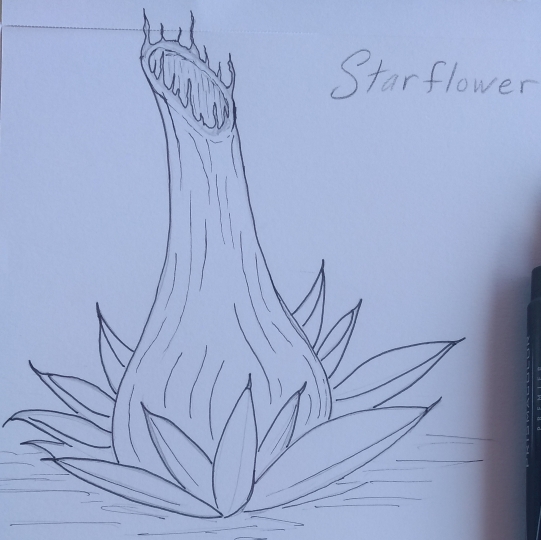
At that point the Starflower explosively launches the Starseed into the night sky, using the delicate fronds at the top to sense nearby stellar bodies for its progeny. The Starflower is blown into pieces by this process, which begins a cycle of regrowth. In being destroyed, the Starflower releases its internal defenders and the re-seeders of the flower: the Sporriors. Waiting encased in the Starflowers flesh are the nascent, ambulatory guardians who spread the Spores wherever they go. The destroyed Starflower’s remains become fertile ground for a new, wider batch of Starflowers, and the process continues.
Starflowers sometimes explode when cut or struck, depending on their state of growth.
If the Starseed escapes the local gravitational body, and makes it into space, and it doesn’t end up in a sun, it will break open upon impact, releasing Sporriors from their layered interiors and providing organic material for their new Spores to grow upon. If the Starseed doesn’t make it to space, when it falls back down it breaks open and seeds a new area.
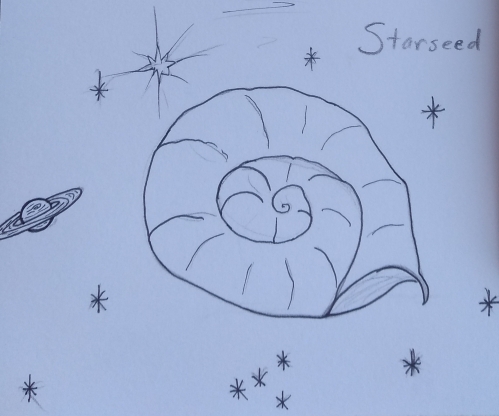
In the asteroid fields and on the tiny iceballs in the depths of dim interstellar space the Starflowers grow slowly and are only large enough to launch little starseeds away from their host body. They release tiny little Sporriors to slowly crawl around spreading new Starflowers.
On planets like Earth with rich local organic deposits, a warm nearby star, and 1G local gravity, the Starflowers will quickly grow to be 90 meters tall or taller before exploding, which launches Starseeds measuring 10-15 meters in diameter. At that size the conical, ambulatory Sporriors released when damaged are 2-3 meters (6-9 feet) tall and in circumference at the bottom of their caps.
Slow but steady walkers, Sporriors spill out from damaged Starflowers and Starseeds, and mill about spreading Spores. They can also climb quite well owing to the hundreds of tiny appendages on the bottom of their trunks. They move very quietly, which combined with their rocky-looking exteriors makes them stealthy.
As they move the Sporriors slowly drip spores suspended in digestive acids, which will grow into Starflowers.
Though lacking a central nervous system or language, they will quietly and steadily walk towards any sound or vibration they sense. And if their tough outer cap touches anything that is moving for more than a moment, be it a sapling or a curious child, they attack.
A hydraulic and chemical reaction causes their conical caps to flip up, inverting. This causes the burning sporewhips, which line the interior of the cap, to fling out in all directions around the Sporrior to a distance of 2-3 meters. The burning sporewhips lie in channels of digestive juices and Spores, and are raspy, so they cut, chemically burn, and possibly infect anything they hit. This reflexive attack also momentarily exposes the Sporriros softer inner cap and stalk.
Sporrior
large fungal plant
Armor Class: 16 (or 9 when attacking)
Hit Points: 48 (4d8+16)
Skills: Stealth +4
Move: 10′, climb 5′
Attack: +4 attack against all creatures within 10 feet / 3 meters, damage 1d4 + 2 slashing, 1d3 acid, and DC 12 Constitution Saving Throw or become infected with burning, itching, tiny-Sporeflower-growing spores. Unless treated with healing magic, technology, or DC 12 Medicine skill checks, the digesting spores will eat away at the infected creature’s body, spreading and dealing 1d12 Hit Points of damage per day.
Challenge Rating: 1
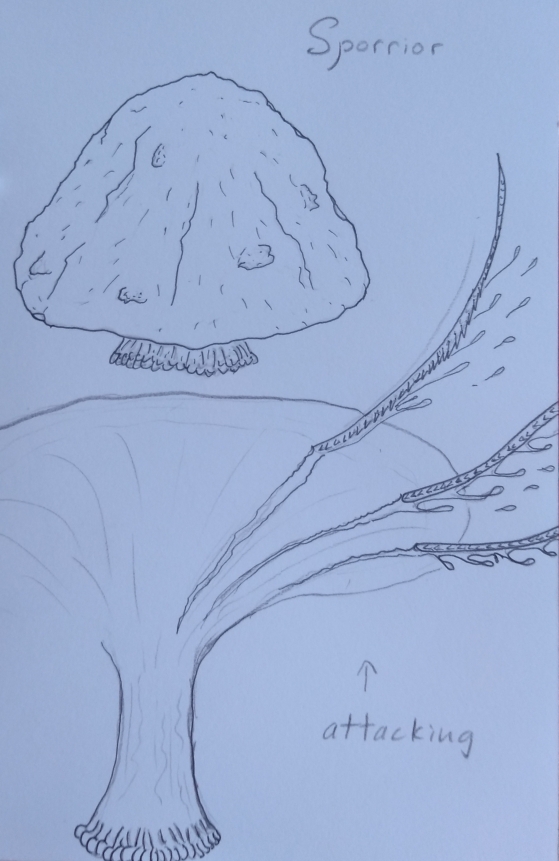
Posted in 3rd edition Dungeons & Dragons / d20 fantasy / Pathfinder, 5th edition Dungeons & Dragons, Creature, d20 Future, D20 Modern, Gamma World, Post-Apocalyptic, Science-Fiction and tagged alien, fungus by Adam A. Thompson with no comments yet.
Dwarven Death Knight
Medium undead, lawful evil
Armor Class 19 (plate armor), 21 (shield of faith)
Hit Points 67 (8d8+24)
Speed 25 ft.
Proficiency +3
STR 19 (+4) DEX 10 (+0) CON 16 (+3) INT 10 (+0) WIS 12 (+1) CHA 15 (+2)
Saving Throws Dex +3, Wis +4, Cha +4
Damage Resistances fire
Damage Immunities poison; necrotic
Condition Immunities charmed, exhausted, frightened, poisoned
Senses passive Perception 11, darkvision 120 ft.
Languages Common, Dwarven
Challenge 6 (2,300 XP)
Actions
Multiattack. The death knight makes two Frost Brand attacks.
Frost Brand. Melee greatsword: +7 to hit, reach 5 ft., one creature. Hit: 7 (2d6 + 4 slashing and 1d6 cold damage).
Spellcasting. The death knight is a 8th level spellcaster. Its spellcasting ability is Charisma (spell save DC 13, +5 to hit with spell attacks). It has the following spells prepared:
1st level: (4 slots): shield of faith, thunderous smite, bless, searing smite
2nd level: (3 slots): aid, branding smite
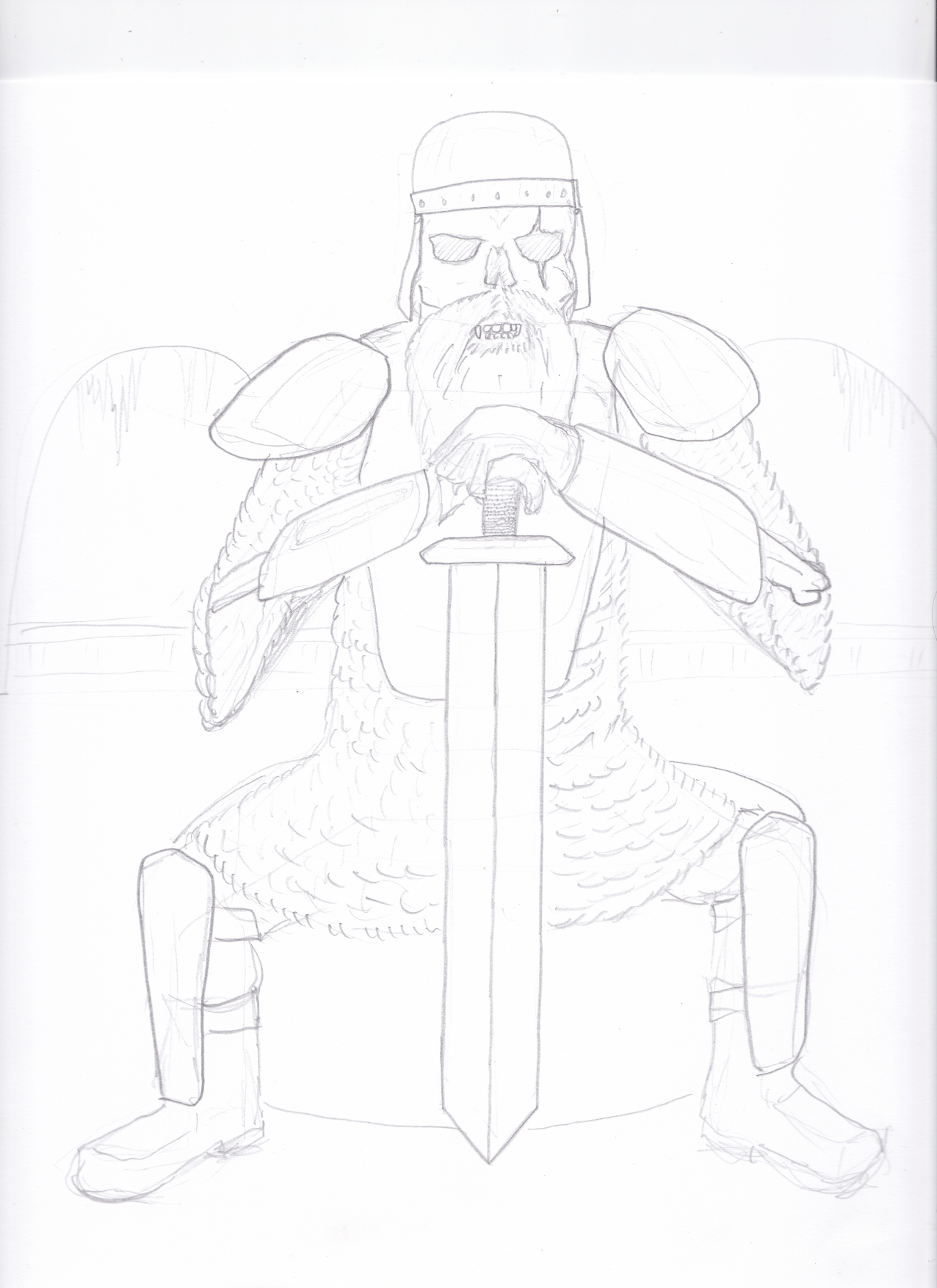
Posted in 5th edition Dungeons & Dragons, Character, Creature, Uncategorized by Adam A. Thompson with no comments yet.
Ghost Snakes (arcanalisti spectralis)
These ghostly snakes are the remnants of magic users who befell disaster while traveling through the astral realms. Their bodies are empty husks, but the souls of some remain, thirsty for magical energy.
At first glance they look like faintly glowing transparent snakes or eels who swim through the air, winking in and out of sight and passing through objects. As they move and attack it becomes clear that they are actually little ghostly skulls with vertebra trailing behind, surrounded by an odd glow of magical energy.
Small undead, chaotic evil
Armor Class 7
Hit Points 3 (1d6)
Speed fly 30 ft.
Proficiency +2
STR 11 (+0) DEX 14 (+2) CON 10 (+0) INT 12 (+1 WIS 8 (-1) CHA 6 (-2)
Senses passive Perception 9
Languages none
Challenge 1/8 (25 XP)
Arcane Absorption. If a ghost snake is reduced to 0 HP with a magical spell it is not destroyed, but instead disappears until its next turn, when it re-incorporates at full health and 3 temporary hit points (for a total of 6 HP) and +1 to attack and damage.
Incorporeal Movement. Ghost snakes can move through other creatures and objects as if they were difficult terrain. A ghost snake takes 5 (1d10) force damage if it ends its turn inside an object.
Actions
Bite. Melee Spell Attack: +3 to hit, reach 5 ft., one creature. Hit: 3 (1d6 force damage) and if the target is a spellcaster the ghost snake gains temporary hit points equal to the damage done.
Posted in 5th edition Dungeons & Dragons, Creature, Fantasy by Adam A. Thompson with no comments yet.
The Black Hand
Beyond the goblin wastes, in his stronghold The Tower of Zards, the foul necromancer known only as The Black Hand uses his evil magic to terrorize and enslave the people of Mystra. Bands of walking dead attack wayfarers, armies of corpses clash with forces of the living, and when The Black Hand visits a battlefield even greater horrors arise.
It is said that only heroes who have been granted the boon of the gods at the Temple of Kings will be able to pass the mystical wards and defeat the demon that guards the tower.
Medium undead, lawful evil
Armor Class 16 (natural armor)
Hit Points 49 (9d8)
Speed 30 ft.
Proficiency +4
STR 11 (+0) DEX 14 (+2) CON 12 (+1) INT 18 (+4) WIS 12 (+1) CHA 11 (+0)
Saving Throws Int +7, Wis +4
Skills Arcana +7, History +7
Damage Resistances cold, lightning, necrotic
Damage Immunities poison; bludgeoning, piercing, and slashing from nonmagical weapons
Condition Immunities charmed, exhausted, frightened, paralyzed, poisoned
Senses truesight 120 ft., passive Perception 14
Languages Common, Dwarven, Giant, Draconic, Infernal
Challenge 9 (5,000 XP)
Spellcasting. The Black Hand is a 9th-level spellcaster. It’s spellcasting ability is Intelligence (spell save DC 16, +8 to hit with spell attacks). The Black Hand has the following spells prepared:
Cantrips (at will): chill touch, ray of frost, true strike, minor illusion
1st level (4 slots): shield, magic missile, thunderwave
2st level (3 slots): misty step, ray of enfeeblement, hold person, mirror image
3st level (3 slots): fireball, counter spell, vampiric touch
4th level (3 slots): fire shield, ice storm
5th level (1 slot): cone of cold
Actions
Paralyzing Touch. Melee Spell Attack: +7 to hit, reach 5 ft., one creature. Hit: 7 (2d6 cold damage). The target must succeed on a DC 15 Constitution saving throw or be paralyzed for 1 minute. The target can repeat the saving throw at the end of each of its turns, ending the effect on itself on a success.
Posted in 5th edition Dungeons & Dragons, Character, Creature and tagged Prophecy of the Summer Frost, Tower of Zards by Adam A. Thompson with no comments yet.
Hyperspace Horrors, FTL Fiends, and Warp Devils
Called space demons by some, these horrifying creatures are believed to originate from outside the known universe. Scientists posit that they are a psionic phenomena, manifesting in our perceived reality through unknown processes. Experiments with psionics or jump space technology that manipulate the fundamental laws of physics have sometimes been known to manifest these types of creatures.
Varied in appearance, these creatures display anatomies and abilities with little resemblance to most life-forms of known space. Some seem to have intellects and psychic powers, while others seem to simply be ravenous beasts. Many have horrible or impossible-seeming physiology, such as the lack of an apparent skin, multiple heads, or protruding bones.
The following creatures are just a few examples of the types of creatures that sometimes come to the Travellers’ universe from outside normal space.
Imposter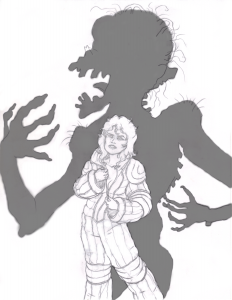
First encountered during the Second Imperium when a rogue scientist used surgery and mutagens to stimulate psionic abilities in test subjects. Investigators believe some type of alien entity or psionic parasite merged with one of the test subjects and gained control of the host. The resulting hybrid creature then propagated its kind among the other test subjects. After contact was lost with the base one of the first squads of Imperial anti-psyker Inquisitor-Marines was sent to cleanse the research station. Cleansing the station resulted in significant casualties, including incurable insanity in the lead Inquisitor.
These creatures have strong psionic powers and are able to command sentient creatures and project a false appearance into other’s minds. They will endeavor to separate a group and use a false appearance to ambush lone members when their guard is down. Fairly intelligent, they will often retain many of the skills of their host. Some will eat the brains and bodies of their victims, though they will instead infect psionic creatures with the psychic parasite. Groups of them coordinate using telepathy.
Appearance – Horribly disfigured humanoid creatures with gaping maws of razor-sharp teeth.
size 6 (50 kg)
Strength 2d6 (7), Dexterity 2d6 (7), Endurance 2d6 (7), Intelligence 8, Instinct 8, Pack 2, Psionic 12
Skills – athletics 0, melee 0, recon 0, survival 0, (any other from host – often includes gun combat 0), psionics (telepathy) 3
Weapons – teeth 1d6 damage (or by weapon)
Armor – 2 (or humanoid armor as available)
Ravager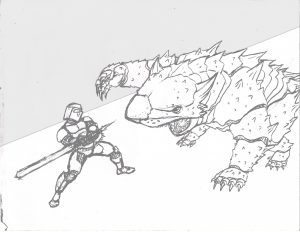
An incident on the research station at a Lagrange point of Zaftel IV resulted in the death of the entire science staff. Video footage recovered from the station shows the staff being torn to pieces by a large creature that appeared during tests of the short-distance teleportation experiment being conducted there. Although quarantine procedures were properly followed, the creature somehow managed to get on board the first rescue ship and kill several of their crewmembers before it was destroyed.
Appearance – A hulking brute with claws, teeth, chitinous plates, spikes and horns, resembling a huge demonic dog.
size 9 (450 kg)
Strength 4d6 (14), Dexterity 2d6 (7), Endurance 4d6 (14), Intelligence 4, Instinct 8, Pack 3
Skills – athletics 2, melee (claws and teeth) 2, recon 1, survival 0, psionics (teleportation) 1
Weapons – claws and teeth 2d6+2 damage
Armor 6
Impregnator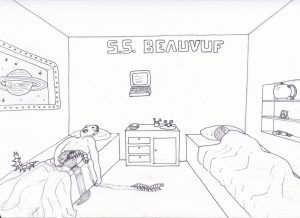
These small parasites were discovered when they overwhelmed a colony ship following a misjump. They have a hypnotic psi power, which they use to pacify a target and implant their spawn. Within a few days the host dies as the parasites consume their internal organs, all the while using their growing psychic powers to kept the victim insensitive to the pain.
Appearance – Many-legged insect-like creatures, with huge mandibles and a long egg-injecting stinger.
size 3 (6 kg)
Strength 1d6 (4), Dexterity 2d6 (7), Endurance 2, Intelligence 4, Instinct 8, Pack 5, Psionic 7
Skills – athletics 2, melee (teeth) 2, recon 1, survival 0, psionics (telepathy) 1
Weapons – teeth 1d6 damage
Armor 3
Art by Spencer Nuzum and Adam A. Thompson
Posted in Creature, Traveller by Adam A. Thompson with 2 comments.
The Mantid
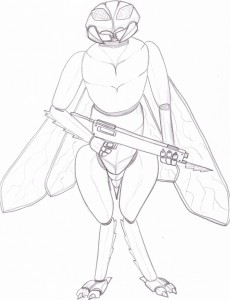 Highly adaptive, fast-evolving, scavenging insectiods, the Mantid are an alien species spread through the Skein Reach. Terrans describe them as looking like a cross between a praying mantis, a wasp, or a humanoid ant.
Highly adaptive, fast-evolving, scavenging insectiods, the Mantid are an alien species spread through the Skein Reach. Terrans describe them as looking like a cross between a praying mantis, a wasp, or a humanoid ant.
Individuals and colonies vary considerably as the Mantid’s genomes will adapt newly laid members to their environment within a few generations. Thus it is common so see a population of Mantid that are adapted to a tiny abandoned space station, or a world with an otherwise toxic atmosphere. Their carapace can be of any color based on available minerals and their place in Mantid society. For example, warriors will often have dark stripes or patterns contrasting with grays or earth tones. The statistics presented below represent typical examples of those who are adapted to living on starships or space habitats.
The Mantid are extremely social creatures and demonstrate high degrees of cooperation and devotion to their colony. Though their language is not well understood, xenobiologists postulate that they communicate both with a spoken symbolic language and through pheromones. These chemical communications seem to generate simultaneous emotional responses through a colony – if one is attacked the fight-or-flight response rapidly spreads to all Mantids in a group. Most other sentient creatures find the Mantid’s pheromones unpleasant and describe their habitats as “smelly” or “stinky”. (more…)
Posted in Creature, Location, Race, Region, Traveller and tagged Mantid by Adam A. Thompson with no comments yet.
Blue Ooze
These mindless collections of damp goop consume whatever organic matter they come across. Their acidic nature makes them quick devourers of plants, dead matter, wood, and any animal too slow to escape them. They prefer damp, dark habitats, and do not survive long in direct sunlight or in dry conditions.
Known by sages as “The Scourge of the Lost City of the Magi”, upon first encounter blue oozes may seem to be little more than nuisances. Their contagious nature often causes this first impression to be replaced by alarm at their swift spread during rainy seasons.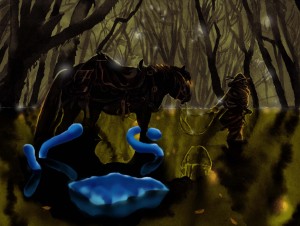
Blue Ooze
Medium ooze, unaligned
Armor Class 8
Hit Points 18 (2d8 + 6) (more…)
Posted in 5th edition Dungeons & Dragons, Creature by Adam A. Thompson with no comments yet.
Skelephant
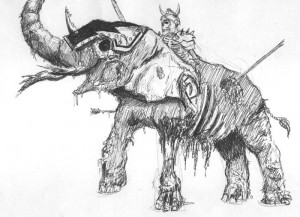
Posted in Creature and tagged undead by Stephen Hilderbrand with no comments yet.
Shadow Sentinels
Those few mariners who have braved the ice isles and their frozen towers will encounter White Eye’s guardians throughout. These pale-eyed living shadows stand as sentinels in the catacombs beneath the towers, and add their victims to the ranks of gray ghouls on the shores.
Shadow Sentinels – CR 8
XP 2,400
N medium undead
Init +0; Senses darkvision 60 ft.; Perception +6
AC 17, touch 17, flat-footed 15 (+5 deflection, +1 Dex, +1 dodge)
hp 83 (8d8+47)
Fort +7, Ref +5, Will +8
Defensive Abilities incorporeal
Immune undead traits
OFFENSE
Speed fly 30 ft. (perfect)
Melee shadow claws +7 (1d6 and 1d6 strength damage)
Special Attacks draining gaze (DC 19)
STATISTICS
Str —, Dex 12, Con —, Int 10, Wis 11, Cha 20
Base Atk +5; CMB +5; CMD 22
Feats Dodge, Improved Initiative, Iron Will, Lightning Reflexes, Toughness
Skills Fly +9, Knowledge (history) +10, Knowledge (nobility) +10, Perception +18, Sense Motive +10, Stealth +9; Racial Modifiers +8 Perception, +8 Stealth
Languages Common
SPECIAL ABILITIES
Strength Damage (Su)
A shadow’s touch deals 1d6 points of Strength damage to a living creature. This is a negative energy effect. A creature dies if this Strength damage equals or exceeds its actual Strength score.
Draining Gaze (Su)
Those meeting the deathly green eyes of the Shadow Sentinels (range 30ft.) must succeed on a DC 19 Fortitude Save or gain 1 negative level.
Create Spawn (Su)
A humanoid creature killed by a shadow sentinel’s Strength damage or gaze attack becomes a gray ghoul under the control of its killer in 1d4 rounds.
Posted in 3rd edition Dungeons & Dragons / d20 fantasy / Pathfinder, Creature and tagged creature type: undead by Adam A. Thompson with no comments yet.